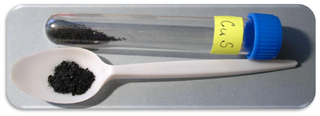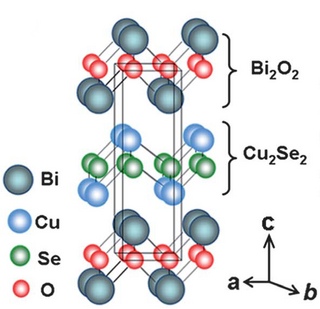Related Research Articles

The chalcogens are the chemical elements in group 16 of the periodic table. This group is also known as the oxygen family. Group 16 consists of the elements oxygen (O), sulfur (S), selenium (Se), tellurium (Te), and the radioactive elements polonium (Po) and livermorium (Lv). Often, oxygen is treated separately from the other chalcogens, sometimes even excluded from the scope of the term "chalcogen" altogether, due to its very different chemical behavior from sulfur, selenium, tellurium, and polonium. The word "chalcogen" is derived from a combination of the Greek word khalkόs (χαλκός) principally meaning copper, and the Latinized Greek word genēs, meaning born or produced.

Selenium is a chemical element with the symbol Se and atomic number 34. It is a nonmetal with properties that are intermediate between the elements above and below in the periodic table, sulfur and tellurium, and also has similarities to arsenic. It seldom occurs in its elemental state or as pure ore compounds in the Earth's crust. Selenium – from Greek selḗnē – was discovered in 1817 by Jöns Jacob Berzelius, who noted the similarity of the new element to the previously discovered tellurium.
In chemistry, the oxidation state, or oxidation number, is the hypothetical charge of an atom if all of its bonds to different atoms were fully ionic. It describes the degree of oxidation of an atom in a chemical compound. Conceptually, the oxidation state may be positive, negative or zero. While fully ionic bonds are not found in nature, many bonds exhibit strong ionicity, making oxidation state a useful predictor of charge.
A metalloid is a type of chemical element which has a preponderance of properties in between, or that are a mixture of, those of metals and nonmetals. There is no standard definition of a metalloid and no complete agreement on which elements are metalloids. Despite the lack of specificity, the term remains in use in the literature of chemistry.

Arsenic trisulfide is the inorganic compound with the formula As2S3. It is a dark yellow solid that is insoluble in water. It also occurs as the mineral orpiment, which has been used as a pigment called King's yellow. It is produced in the analysis of arsenic compounds. It is a group V/VI, intrinsic p-type semiconductor and exhibits photo-induced phase-change properties.

In chemistry tellurate is a compound containing an oxyanion of tellurium where tellurium has an oxidation number of +6. In the naming of inorganic compounds it is a suffix that indicates a polyatomic anion with a central tellurium atom.

Selenium dioxide is the chemical compound with the formula SeO2. This colorless solid is one of the most frequently encountered compounds of selenium.
Organoselenium compounds are chemical compounds containing carbon-to-selenium chemical bonds. Organoselenium chemistry is the corresponding science exploring their properties and reactivity. Selenium belongs with oxygen and sulfur to the group 16 elements or chalcogens, and similarities in chemistry are to be expected. Organoselenium compounds are found at trace levels in ambient waters, soils and sediments.

Copper monosulfide is a chemical compound of copper and sulfur. It was initially thought to occur in nature as the dark indigo blue mineral covellite. However, it was later shown to be rather a cuprous compound, formula Cu+3S(S2). CuS is a moderate conductor of electricity. A black colloidal precipitate of CuS is formed when hydrogen sulfide, H2S, is bubbled through solutions of Cu(II) salts. It is one of a number of binary compounds of copper and sulfur (see copper sulfide for an overview of this subject), and has attracted interest because of its potential uses in catalysis and photovoltaics.

Phosphorus sulfides comprise a family of inorganic compounds containing only phosphorus and sulfur. These compounds have the formula P4Sn with n ≤ 10. Two are of commercial significance, phosphorus pentasulfide, which is made on a kiloton scale for the production of other organosulfur compounds, and phosphorus sesquisulfide, used in the production of "strike anywhere matches".

Arsenic triselenide is an inorganic chemical compound with the chemical formula As2Se3.

Selenium tetrafluoride (SeF4) is an inorganic compound. It is a colourless liquid that reacts readily with water. It can be used as a fluorinating reagent in organic syntheses (fluorination of alcohols, carboxylic acids or carbonyl compounds) and has advantages over sulfur tetrafluoride in that milder conditions can be employed and it is a liquid rather than a gas.

Selenium compounds commonly exist in the oxidation states −2, +2, +4, and +6.
The thallium halides include monohalides, where thallium has oxidation state +1, trihalides in which thallium generally has oxidation state +3, and some intermediate halides containing thallium with mixed +1 and +3 oxidation states. These materials find use in specialized optical settings, such as focusing elements in research spectrophotometers. Compared to the more common zinc selenide-based optics, materials such as thallium bromoiodide enable transmission at longer wavelengths. In the infrared, this allows for measurements as low as 350 cm−1 (28 μm), whereas zinc selenide is opaque by 21.5 μm, and ZnSe optics are generally only usable to 650 cm−1 (15 μm).
There are three sets of Indium halides, the trihalides, the monohalides, and several intermediate halides. In the monohalides the oxidation state of indium is +1 and their proper names are indium(I) fluoride, indium(I) chloride, indium(I) bromide and indium(I) iodide.

Selenium monochloride is an inorganic compound with the formula Se2Cl2. Although it is called selenium monochloride, a more descriptive name might be diselenium dichloride. It is a reddish-brown, oily liquid that hydrolyses slowly. It exists in chemical equilibrium with SeCl2, SeCl4, chlorine, and elemental selenium. Selenium monochloride is mainly used as a reagent for the synthesis of Se-containing compounds.

Oxyselenides are a group of chemical compounds that contain oxygen and selenium atoms. Oxyselenides can form a wide range of structures in compounds containing various transition metals, and thus can exhibit a wide range of properties. Most importantly, oxyselenides have a wide range of thermal conductivity, which can be controlled with changes in temperature in order to adjust their thermoelectric performance. Current research on oxyselenides indicates their potential for significant application in electronic materials.
A selenate selenite is a chemical compound or salt that contains selenite and selenate anions (SeO32- and SeO42-). These are mixed anion compounds. Some have third anions.
Phosphide iodides or iodide phosphides are compounds containing anions composed of iodide (I−) and phosphide (P3−). They can be considered as mixed anion compounds. They are in the category of pnictidehalides. Related compounds include the phosphide chlorides, arsenide iodides antimonide iodides and phosphide bromides.

In chemistry, a selenosulfide refers to distinct classes of inorganic and organic compounds containing sulfur and selenium. The organic derivatives contain Se-S bonds, whereas the inorganic derivatives are more variable.
References
- ↑ Blachnik, R.; Lönnecke, P.; Boldt, K.; Engelen, B. (1994). "P2Se5". Acta Crystallographica Section C. 50 (5): 659–661. doi:10.1107/S0108270193010534. ISSN 0108-2701.
- ↑ Blachnik, Roger; Lönnecke, Peter (1992). "From P4Se3I2via P3Se4I to P2Se5". Phosphorus, Sulfur, and Silicon and the Related Elements. 65 (1–4): 103–106. doi:10.1080/10426509208055329. ISSN 1042-6507.
- ↑ Keulen, E.; Vos, A. (1959). "The crystal structure of P4Se3". Acta Crystallographica. 12 (4): 323–329. doi: 10.1107/S0365110X59000950 . ISSN 0365-110X.
- ↑ Penney, G. J.; Sheldrick, G. M. (1971). "Crystal and molecular structure of tetraphosphorus pentaselenide". Journal of the Chemical Society A: Inorganic, Physical, Theoretical: 245. doi:10.1039/j19710000245. ISSN 0022-4944.
- ↑ Ruck, Michael (1994). "Darstellung und Kristallstruktur des ersten polymeren Phosphorselenidscatena-(P4Se4)x". Zeitschrift für Anorganische und Allgemeine Chemie. 620 (10): 1832–1836. doi:10.1002/zaac.19946201028. ISSN 0044-2313.
- ↑ Blachnik, R.; Lönnecke, P.; Nuß, J. (1994). "Neues vom P4Se4". Zeitschrift für Anorganische und Allgemeine Chemie. 620 (1): 160–166. doi:10.1002/zaac.19946200126. ISSN 0044-2313.
- ↑ Pfitzner, A.; Reiser, Sara (1999). "(CuI)3P4Se4: β-P4Se4Cages between Columns of Copper Iodide†" (PDF). Inorganic Chemistry. 38 (10): 2451–2454. doi:10.1021/ic981042f. ISSN 0020-1669.
- 1 2 3 Corbridge, D.E.C (2013). Phosphorus: Chemistry, Biochemistry and Technology. CRC Press, Taylor Francis Group. p. 808. ISBN 978-1-4398-4088-7.
- 1 2 Devillanova, Francesco, ed. (2007). Handbook of Chalcogen Chemistry –New Perspectives in Sulfur, Selenium and Tellurium. Royal Society of Chemistry. ISBN 9780854043668.
- 1 2 Holleman, Arnold Frederik; Wiberg, Egon (2001), Wiberg, Nils (ed.), Inorganic Chemistry, translated by Eagleson, Mary; Brewer, William, San Diego/Berlin: Academic Press/De Gruyter, ISBN 0-12-352651-5
- ↑ Housecroft, Catherine E; Sharpe, Alan G (2005). Inorganic Chemistry (2d ed.). Pearson education. p. 427. ISBN 978-0-13-039913-7.
- 1 2 Georgiev, D.; Mitkova, M.; Boolchand, P.; Brunklaus, G.; Eckert, H.; Micoulaut, M. (2001). "Molecular structure, glass transition temperature variation, agglomeration theory, and network connectivity of binary P-Se glasses". Physical Review B. 64 (13): 134204. Bibcode:2001PhRvB..64m4204G. doi:10.1103/PhysRevB.64.134204. ISSN 0163-1829.
- ↑ Eisenmann, B.; Hansa, J. (1993). "Crystal structure of tetrasodium decaselenotetragermanate, Na4[Ge4Se10]". Zeitschrift für Kristallographie. 205 (Part-2): 325–326. Bibcode:1993ZK....205..325E. doi:10.1524/zkri.1993.205.Part-2.325. ISSN 0044-2968.